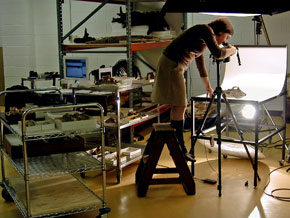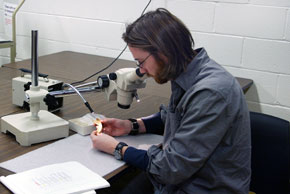Research
Every year, hundreds of scientists from around the world visit museums to work on their collections. Museums also lend specimens from their collections to scientists so that they can be worked on at their own institutions. What do they do with these specimens, and how can specimens of fossil perissodactyls help us understand the evolution of this group and the wider world in which we live?
Since the beginning of paleontology, fossils have been used to reconstruct the evolutionary sequence of life. Because there are gaps in the fossil record the evolutionary relationships of different species is not always easy to understand and paleontologists and other biologists can strongly disagree about how different species are related. Therefore, paleontologists use a sophisticated set of methods to analyze how different groups of animals are related. This leads them to develop hypotheses about how the group may have evolved. We do this by looking at the distribution of characters among different species. You can read more about this type of work, and try some activities for yourself, by visiting the “Concepts” section of this site. The discovery of new fossils – either new types of animal, or more complete specimens of ones that are already known – often provides new information that can change our ideas about how organisms are related.
Studying the remains of animals can tell us more than how they were related. By reconstructing the position of muscles and other soft tissues on the surface of the bones, it’s possible to get some idea of what the animal looked like in life. As our knowledge of animal anatomy improves, we can make more accurate reconstructions. This is an area where scientists often work closely with artists. You can read about one example of this sort of collaboration, involving the Central Asian brontothere Embolotherium by clicking here. Reconstructing muscles can also help us to calculate the mechanical force they could exert and this allows researchers to estimate, for example, how fast an animal could run, or how powerful its bite was.
Sometimes, as at the Ashfall site or at Messel, there are exceptionally well-preserved fossils that retain traces of stomach contents. From these we can find out what the animal ate. However, new scientific techniques mean that we can also get evidence about diet from a much wider range of fossils. Dental microwear is the study of the microscopic scratches and pits that form on a tooth's surface as the result of its use. Heavily pitted molar surfaces typically suggest a diet consisting of harder, more brittle food items (such as hard seeds, nuts or bone). Heavy scratching on the shearing facet of a molar usually indicates that that tooth was used to shear tough food items (such as leaves or meat). Intermediate patterns indicate mixed diets, or diets with intermediate food properties (such as soft fruits).
Even without studying microwear , it’s still possible to get evidence about diet. Carbon isotopes are taken up through the diet of animals during their lifetime – by using a technique called stable isotope analysis to study the ratios of these isotopes in their fossilized bones, it’s possible to discover, for example, whether an herbivorous animal was primarily a grass eater or leaf eater. Dietary information is important not only because of what it tells us about the animal itself; knowing what vegetation was present can help us reconstruct the environment in which it lived.
Another way of discovering information about ancient environments is by looking at the variety of fossils present from a particular site and comparing them to the assemblages of plants and animals that live together in different areas today. The animal assemblage of a particular area is called the fauna, while the plant assemblage is called the flora. The fauna and flora can tell researchers whether, for example, the area was mostly forested at the time the fossils were preserved, or whether it was grassland. Sometimes a site will contain fossils from several different time periods, separated by hundreds of thousands, or even millions of years. A change in the types of animals present over time, e.g. from mostly browsers to mostly grazers, may be evidence of long-term climate change.
Once scientists have completed their work, they publish it in a scientific journal. This is important, because it lets other researchers, as well as the wider public, know about their discoveries. Papers get reviewed critically by other scientists before they can be published to assess, for example, whether the author has provided sufficient evidence to support their conclusions. This peer review is important, because it means that anyone reading the paper can have a fair degree of trust that the information in it is accurate. Papers describing museum specimens always give the catalog numbers of the specimens that were studied, which allows other researchers to go back and check the work of the author if they are skeptical about their results. This is another important mechanism for building trust.
Mick Ellison is a scientific illustrator and photographer in the Division of Paleontology at the American Museum of Natural History. To see his project on a a new reconstruction of the Central Asian brontothere Embolotherium, click on the link below.



